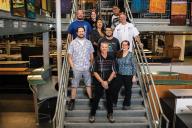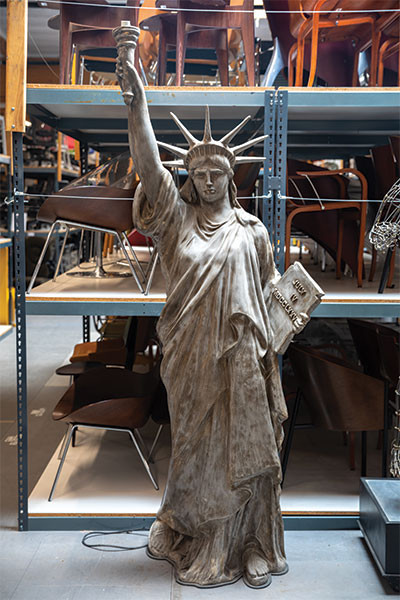Does your next production need seating that's whimsical yet worthy of a royal rear?
Slide into the star–shaped stunner at Modern Props, a prop house that provides everything from spoons to an entire spaceship command station to television and film productions, commercials, music videos, photo shoots and even party rentals. One of about 70,000 available items, the oversized welded-aluminum chair appeared in a dream sequence in The Big Bang Theory.
Founded in 1977 by John Zabrucky, a former Ohio art instructor who is still the CEO, Modern Props operates out of 80,000 square feet spread over two buildings in San Fernando, in northwestern L.A. County. The firm moved there in April 2017 after 22 years in Culver City.
Besides The Big Bang Theory, current clients include NCIS, Lethal Weapon, Jane the Virgin, Single Parents, The Orville, and the Veronica Mars reboot.
"Our catchphrase is, 'Our things help bring your creative imagination to life,'" says Modern Props president Ken Sharp. "When people say [about an item], 'What is this?' we say, 'What do you want it to be?'"
The company's own creativity is evident upon entering the main showroom, where the extensive inventory demands clever use of space. Artwork of all sorts — such as pop images and black-and-white travel prints — lines the walls. A collection of fake framed gold records overlooks a staircase.
Modern office desks share floor space with sltylish dressers of various eras, while shiny white bathtubs sit nearby.
Aisle upon aisle of seating juxtaposes the mundane and the marvelous: from black-leather office swivels to sleek geometrics by famed Danish designer Verner Panton resembling giant ladles. One standout, acquired at a Milan furniture fair, is a chair made of crushed granite.
Lamps range from art deco to lava to hula dancers, while drinking glasses are artfully aligned by color. There's a miniature Tower of Pisa and a small Statue of Liberty, as well as a forest of barren white trees and even a statue of an Egyptian mummy.
"Our large furniture items rent the most often," Sharp says, "but we have all these other items to go with them — table sculptures, floor sculptures. Wall art is very big for us."
In its 10,000-square-foot fabrication shop, Modern Props designs and builds some furniture from scratch, such as an aluminum vanity coated with three layers of white paint. That's what it takes to get the gloss just right for the camera.
"Aluminum is sturdy," Sharp explains. "This industry is so rough — things get dragged around. When we build something, we think, 'How's it going to be treated? What can we do to protect it from damage?'" The same thinking applies to acquired pieces, like an Italian credenza that was modified to include casters and a skid plate.
Staffers fabricate much of the space-themed and electronic equipment on site. "We build our circuit boards from scratch," Sharp says. "You don't just plug something in and hope it works." Items are produced after extensive research and development. Like everyday products, they have safeguards: a one-of-a-kind futuristic chair, for instance, has a handle built into its base for easy lifting.
Probably the most impressive sight: the house-built spaceship command station, a set unto itself complete with swivel chairs, consoles and panels that would do Captain Kirk and Mr. Spock proud. Controls bear such notations as Air Pressure, Ventilation, Engine Performance and, of course, Danger.
The space also houses cylinders, computer stations and lab equipment. Overhead, a miniature flying saucer is frozen in a near-collision with a model of the Earth. Various handheld devices are ready to be whatever a script requires: weapons for protection or explosives to be deactivated before they blow up a building — or a planet.
"Most of what we do is prototype stuff," Sharp says. One eye-catching wall is lined with vertical racks that, like the spaceship command station, sport hundreds of knobs and various technical intricacies. What's it for? "Something super-futuristic or a military ship," Sharp suggests. "An expert from the Navy saw it and said, 'It's so real, we could train people here.'"
That praise resonates with Sharp. "After 40 years," he says, "we continue to follow the founding principle: providing well-maintained, quality props and professional services."
That's a timeless goal, and it's still modern after all these years.
This article originally appeared in emmy magazine, Issue No. 1, 2019














































